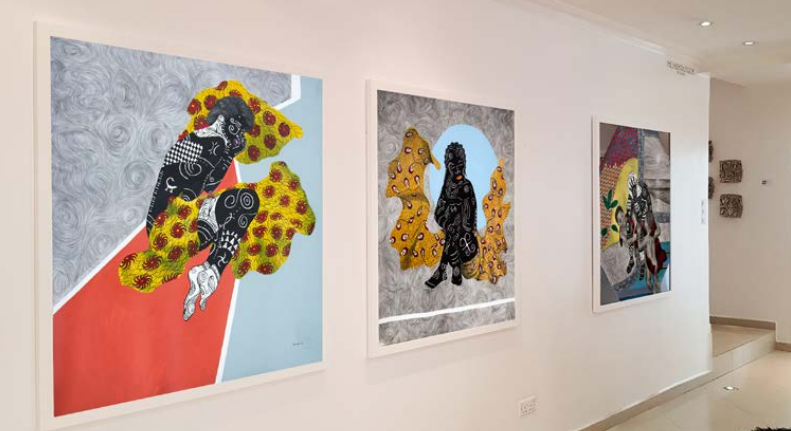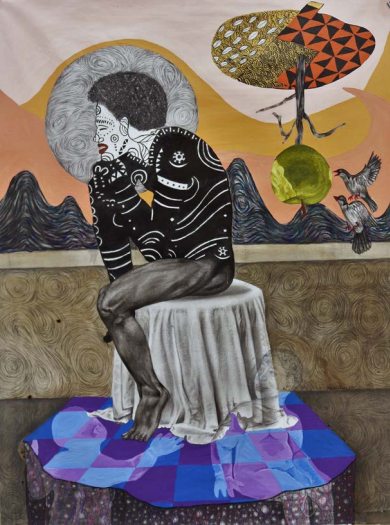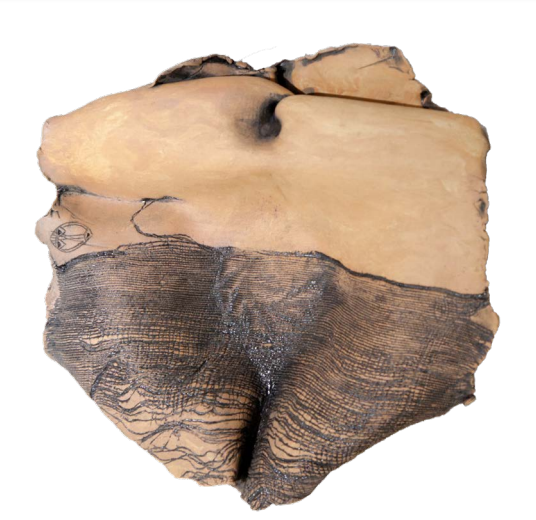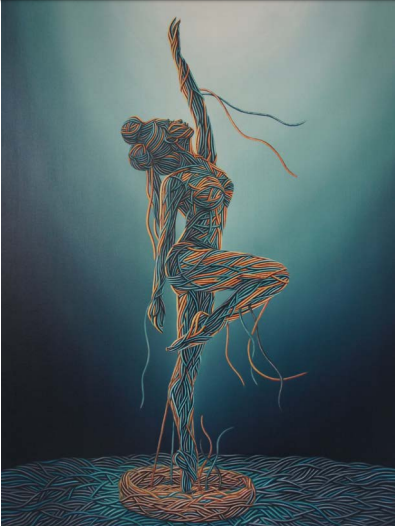In a world competing for every part of our consciousness, how do we achieve equilibrium and actual wellbeing? adeoluwa oluwajoba takes a look at Stasis.

The group exhibition, STASIS, presented by SMO Contemporary Art features work by three contemporary artists: Olawunmi Banjo and Kelechi Nwaneri from Nigeria and Nathalie Djakou Kassi from Cameroon. Attempting to examine the concept of stasis, that is, how to achieve equilibrium both in our conscious and subconscious mind, the multimedia exhibition presents over 45 recent works of paintings, drawings, and ceramic.
In the curatorial statement, Sandra Mbanefo Obiago writes, “STASIS explores our ability to achieve balance despite societal pressures, mental health challenges, and the effects of climate change on our wellbeing. Each artist explores the struggle between our inner and outer worlds and creates a path to a deepened sense of self-awareness and identity”. This particular struggle for balance visually replicates in the locality and structure of the exhibition. Situated on both floors of the lifestyle concept store—Temple Muse, there is a visual struggle for balance between the works exhibited and the luxury goods on display. It is almost difficult to tell where the store ends, and the exhibition begins. Even before engaging the works, the viewer already confronts matters of equilibrium and navigation. Whether this mode of work presentation is generally effective or not ー the location is used regularly for exhibitions by SMO Contemporary Art ー is up for debate. However, in the context of this exhibition, the site does lend to the reading of the display.

When the viewer gets past the initial problem of navigation, the exhibition slowly comes into focus. We see Nwaneri’s surreal landscapes populated with hybrid bodies shown in various states of repose and dynamic movement. His work examines the constant existential struggle of being caught between opposing forces and the impossibility of choice. Employing symbols and patterns drawn primarily from Adrinka, Uli and Nsibidi forms, Nwaneri’s work alludes to the constant conflict between the conscious and subconscious part of the human mind and the life-long struggle for balance. This struggle, in turn, poses an important question in the context of this exhibition: Is this state of stability ー in which all opposing forces are equal and therefore balanced ー possible, or do we live our lives constantly navigating between both ends of the spectrum?
Djakou Kassi’s work explores the malleable qualities of her preferred medium, clay. Her work ranges from soft, undulating, often convoluted shapes, as seen in the Reduce and Reuse (2019) series, to utilitarian ceramic jars and bowls adorned with masks, motifs and patterns derived from African iconography. The viewer simultaneously engages with the objects’ perceived solidity and fragility. Inspired by her passion for the environment, Djakou Kassi presents the earth as a beautiful, stable entity capable of enduring the harshest treatment. She also subtly reminds us of its fragility and the need for moderation. Like Nwaneri, balance and stability remain a work in progress.

Where Nwaneri and Djakou Kassi’s work seem to be representations of the struggles for balance and equilibrium in human societies, Banjo’s work seem to represent the perfect state of stasis. Working primarily in the traditional medium of oil on canvas, the characters in her work are a convoluted network of coloured wires and cables which lend a textural quality to the forms despite the blended and smooth application of colours. Either as portraits of women or bodies in various states of acrobatic movement, the figures serve as a climax to the exhibition. They seem to say to the viewer, ‘this is what you came here for, this here is stasis’. The paintings, done predominantly in shades of blue, evoke in the viewer a calm that comes with stability and a realisation of self. We gaze at the aftermath of the struggles shown in the works of Nwaneri and, to an extent, Djakou Kassi. At this point, the exhibition is complete.

In Lifted, Banjo presents a male figure suspended mid-air, torso arched, head up-turned, one hand reaching upwards as the other extends towards the ground. His left leg is stretched out with toes pointing downwards, while the other leg forms an angle at his side. The figure is reminiscent of a body in flight held up by a network of wires, like an aerial dance performance and for a minute we picture ourselves as this figure. Boundless, limitless but ironically tethered. Leap of Freedom, another painting by the artist, portrays a female character in a similar pose, albeit still in the early stages of rising but shown breaking free from the wires that held her down in what looks like a bird’s nest. Compared to Lifted, the audience recognises notions of flight and freedom, support and individuality. We are familiar with these figures, and we are intrigued by them even.
In the unconventional depiction of the human skin and the materiality of this representation, Banjo’s works present the human body as an interconnected system of individual elements that make up the whole, while also alluding to the human ability to serve as a conduit capable of a range of emotions. It is the ability to find a balance despite this flurry of emotions that leads to the symmetry of being.
In an increasingly reactionary yet constantly changing world vying for every part of our consciousness, the exhibition probably wants to draw the viewer’s attention to the need to achieve balance amidst societal pressures, mental health challenges, and the effects of climate change on our wellbeing. The intricate, layered and multidimensional works presented, provide the viewers with a point of departure into examining the complex relationship between the human body and contemporary society and how the latter affects the mind. The exhibition places the viewer in a conversation with the multiplicity of form present in the show, revealing how the human body and mind exist in a perpetual state of renegotiating its relation to the physical space.
The exhibition runs till October 18, 2019.




